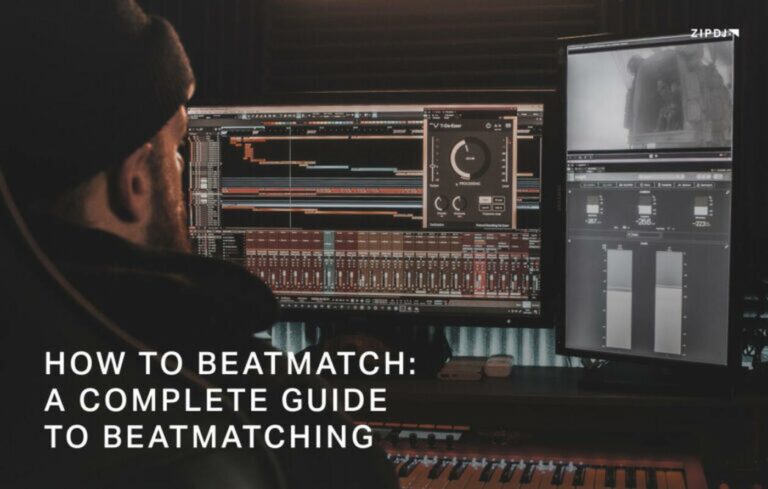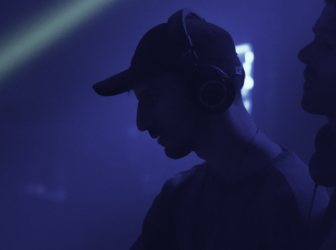How To Beatmatch: A Complete Guide To Beatmatching

Learning how to beatmatch is essential for anyone looking to excel as a DJ and perform more dynamic and professional mixes.
In this guide, we’ll explain how to match beats from two songs like a pro, delivering extended mixes where you can fully explore the features of your DJ controller.
Continue reading for a complete step-by-step guide to beatmatching, from using the correct equipment to finding a cue point to set up the perfect mix.

How To Beatmatch: A Complete Guide To Beatmatching
There are several crucial elements to consider when performing a great beatmatch mix, beginning with the song’s tempo and using the jog wheels and pitch sliders to pull off.
We’ve considered everything you need to know to master this technique and take your DJing skills to new heights.
Without further ado, here’s our complete guide to beatmatching:
What Is Beatmatching?
Beat matching is one of the first tips to improve your DJ skills beginners learn, and once it has been mastered, it opens up many more mix transitions to bring variety to your sets.
This technique facilitates smooth transitions between two songs, so the rhythm and beats blend for a clean mix.
It enables DJs to match beats, calculate the song’s tempo in beats per minute (BPM), and adjust the pitch slider to raise or lower the tempo on each track until they match.
Why Learn To Beatmatch?
While many DJs rely on the sync button to play tracks with matching tempos, this tool can be unreliable, so learning to beatmatch is necessary when it lets you down.
When the sync button gets the beat grid wrong, you’ll need to step in and manually beatmatch to ensure a smooth transition with the upcoming track.
Moreover, learning beatmatching over a prolonged period gives you time to explore effects and utilize the EQ, creating new soundscapes for more nuanced DJ sets.
How To Beatmatch (Step-By-Step)
Now that we’ve run through the key advantages of beatmatching, let’s take a closer look at how you can accomplish this technique yourself.
Remember, practicing this skill regularly is essential if you want to master it, so persevere if you’re struggling to nail this at first.
Once you gain confidence, experiment with different genres and tempos played by other DJs to broaden your repertoire and gain more experience.
Step 1: Select The Best Equipment
Before you can beatmatch, you’ll need to ensure you have the correct DJ controller and other equipment capable of performing this technique.
Whether you’re learning how to beatmatch on CDJs or how to beatmatch vinyl, having the best equipment possible will make the process simpler and more enjoyable.
Most DJ equipment will include a tempo slider in the hardware, which you can use to increase or decrease the tempo of the tracks playing.
You can get more features from the best DJ controllers, which include auto-match tools with a sync button to bring two tracks to the same BPM.
You’ll also need a pair of headphones to check the incoming track before introducing it to the mix and ensure it’s playing at the same tempo as the currently playing track.
Step 2: Choose Your Preferred Genres
Your track selection process begins with picking the genre you want to play, whether this is deep house, techno, or a broader selection of dance music.
If you’re new to DJing, choosing tracks from the same genre is a good place to start, with house music among the most popular genres for learning to beatmatch.
Most electronic music genres are great for beatmatching, so pick the one you have a decent musical knowledge of, as you’ll be in familiar territory.
Step 3: Select Tracks To Mix
Before you start, choose two tracks you want to mix, ideally with a basic intro and outro featuring the kick drum and avoiding too many elements playing simultaneously.
Most dance music tracks will include these sections, so keeping it simple and minimizing the distracting elements makes it easier to mix songs together.
If you’re wondering where DJs get their music, there are many online resources to buy music or download tracks for free, ranging from online specialist record stores to the best record pools.
If you sign up for a record pool, you’ll also gain access to information on tracks, such as their native key and original tempo, helping you to organize your content for instant mixing.
Step 4: Match The Tempo
Once you’ve selected the music you want to beatmatch, the first practical step to achieve this easy DJ transition is to match the tempo of both tracks.
The beatmatching process requires both tracks to play together so that the number on the BPM counters, included in most modern DJ software, are the same tempo.
The quickest way to sync is to use the sync feature on a DJ controller, which allows you to instantly match the BPM by pressing the sync button.
While this feature is usually accurate and makes beatmatching easier, it can sometimes be imprecise, so you’ll also need to learn how to beatmatch by ear to become a competent DJ.
If you want to follow in the footsteps of traditional DJs and beatmatch manually, you can adjust the pitch fader on the first track until it reaches the same speed as track B.
While the initial track plays through the main speakers, you can tweak the tempo slider for the incoming track by using the jog wheel to drop it at the beginning of a bar.
Step 5: Find A Cue Point
Now that you have your two tracks beatmatched, it’s time to select the cue point on the first track where you want to start playing the second track.
Cue points work best when they come at the end of a big drop or musical phrase, giving you an easily identifiable buildup to the first beat of the mix.
For smooth transitions, listen carefully to any additional noises aside from the kick drums and percussion to ensure no harmonic clashes or other conflicting sounds once the second track drops.

Step 6: Adjust The Incoming Track
As you approach the cue point, you’ll need to set up the incoming track to begin in the right place, using the jog wheels to make any adjustments to its BPM.
If you aren’t dropping the track in from the very beginning, move the track forward and find the first beat of the point where you want to bring it in, so it’s ready for the cue point.
At this stage, you should also position the EQ settings on the DJ mixer to their starting positions, for example, lowering the low frequencies so when you play track B, basslines and kick drums don’t clash.
Step 7: Mix On The Cue Point
With everything now set up and ready to go, it’s time to bring track B into the mix so that the two tracks play together.
As track A reaches the cue point, get into the rhythm by moving the jog wheel back and forth over the kick drum of track B, counting down the beats as the cue point approaches.
On the cue point’s first beat and kick drum, play track B and bring it into the mix so you can hear it on your monitor speakers.
Step 8: Prevent Clipping With EQs
A schoolboy error many new DJs make when learning beatmatching is clipping, which occurs when the bass and other frequencies from two songs cause distortion and send the volume into the red.
You can adjust the EQ on the tracks independently on the DJ controller, lowering the frequencies on the second track on a particular musical phrase, so the two tracks blend together.
Unleashing the full potential of the EQ is one of the most important DJ techniques and can be used for much more than simply preventing clipping.
Step 9: Play With Effects
In addition to adjusting the sound of both tracks with the EQ, you can take advantage of features found on the best DJ mixers and introduce a range of effects.
Various effects are available, including echo and reverb effects, to create a more spacious mix on the sound system and phase and flangers effects for more experimental results.
Play around with these DJ sound effects and learn what works best with the style of music you prefer to DJ with.
Step 10: Rinse & Repeat
Once you’ve mixed out the outgoing track, repeat the process and match the tempo for the next song you want to bring into the mix.
If you want to improve in the future, you can find out how to live stream your DJ sets and ask for feedback from your fans and other viewers.
The more you practice beatmatching, the better you’ll get at making the most of various elements featured in two songs and energizing the crowd on the dance floor.
FAQs About Beatmatching
Still unsure about beatmatching and how it can help elevate your technical mixing skills to the next level?
We’ve compiled this handy FAQ guide to cover some of the most common sticking points new DJs have about this fundamental technique.
1. Who Invented Beatmatching?
American DJ Francis Grasso first invented beatmatching in the 1960s and 1970s, with the introduction of the mixer allowing him to listen to tracks independently.
He initially beatmatched by ear using a metronome to count the track tempo of vinyl records before using the pitch control to adjust the BPM.
2. What Are The Benefits Of Beatmatching?
Beat matching has many benefits, teaching you the importance of rhythm and allowing you to easily mix tracks with various tempos.
Master this skill, and you can work with DJs in a professional setting and pick tracks that complement one another, performing extended blended mixes.
3. How Hard Is It To Beatmatch?
Beat matching is one of the primary mixing techniques all DJs need to learn, and mastering this skill requires patience and perseverance.
After grasping the basics, work on mixing two records that play for an extended period, introducing new mixing techniques as your confidence grows.
4. How Long Does It Take To Learn To Beatmatch?
While everyone learns new skills at different rates and proficiency, matching beats to a high standard can take several months.
As your beatmatching skills improve, you can experiment with more challenging tracks and genres, introducing new techniques such as harmonic mixing.
Summary
That wraps up this complete guide to beatmatching, and if you follow these steps and put them into practice, you’ll be mixing professional-sounding mixes in no time.
Beat matching is a core foundation of mixing, so master this skill, and a variety of more advanced DJ techniques will become available for you to add to your repertoire.
Once you’re comfortable beatmatching your favorite genres, have fun and introduce more variety of style and tempo to give your sets even more personality.
Access a comprehensive library of music in ZIPDJs record pool, complete with BPM counters to help you match beats like a pro.
Not a member ?
Join Today for Unlimited Music Downloads. Visit zipdj.com for more information.



